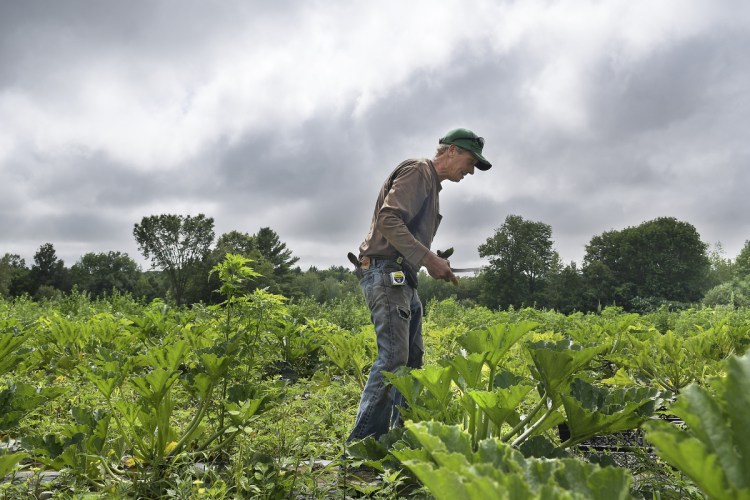Cynthia Turcotte and Tom Fair can see both sides of this summer’s dry weather.
While they’ve had to haul out the irrigation pipes this year to bring water to thirsty crops, Turcotte said, they have spent less time and effort treating crops for the fungus that thrives in wet conditions.
“It has meant a lot more labor,” Turcotte said Tuesday. “We need to drop everything and run the pipes.”
Turcotte and Fair own and operate Applewald Farm in Litchfield, where they grow a wide range of vegetables, as well as apples.
While the apple trees may be fine, crops such as cucumbers and corn require more moisture than nature has delivered. “You have to make sure it’s nice and wet,” Turcotte said.
Despite the humidity that has blanketed the region on and off for weeks, rainfall totals have been well below what’s considered normal.
Tom Hawley, a hydrologist with the National Weather Service office in Gray, said the weather patterns to this point have brought drier conditions.
“Over the last 60 days,” Hawley said, “we’re running 1 to 2 inches below normal. But if you go back 180 days, we’re 4 to 6 inches below normal.”
May was a particularly dry month. In Gardiner, for instance, 0.9 inches of rain fell; 3.5 inches would have been the normal amount.
Through July 17, the U.S. Drought Monitor for Maine shows that southern and southwestern Maine, from Oxford County in the west to Waldo County in the east, is currently in a moderate drought.
That lines runs through southern Kennebec County. Just north of that line, from Oxford County north through Somerset County and across to coastal Hancock County, as well as in the far north of Aroostook County, are stretches of Maine where conditions are considered abnormally dry.
John Bott, spokesman for the state Department of Agriculture, Conservation and Forestry, said the state’s multi-agency Drought Task Force has not yet met this year. A year ago, it already had convened by this time.
“The thing to keep in mind is that we’re the largest and most diverse agricultural state in New England,” he said.
The drought map shows a large portion of the state that is unaffected by dry conditions, but that doesn’t mean that localized areas aren’t experiencing drought, particularly in mountainous regions, where rain falls on one side of the divide while the sun is shining on the other.
“Usually, with agriculture, when something is up, something else is down,” he said. “Somethings do better with more rain and some with less.”
Jeanne Simpson, at Morrison Hill Orchard in Farmington, said she has not seen the effect of the dry summer on the raspberry crop.
“We have blueberries and raspberries,” Simpson said. “The raspberries are doing well, and the blueberries are coming in nicely.”
That has been a bit of a surprise, she said, but thunderstorms around Farmington have brought rain, while in other parts of the state rainy weather has been only a threat.
“I have noticed a difference in the family garden,” she said, which has needed watering this year.
If the dry weather continues, the effect might not be felt until next year on the apple crop.
“It may be a decreased crop, or smaller fruit,” she said.
In Litchfield, Turcotte said she also has expected the last few dry summers to affect the apple crop.
“Last year it was dry, and we anticipated smaller apples, but someone still found a 1-pound apple.”
When less rain falls, sometimes that means fruit has a more intense flavor, she said.
This year’s dry conditions have kept bugs as well as fungus at bay.
“The produce is prettier this year,” she said.
But for those looking for a break from the dry weather, a measure of relief is on the way.
Hawley, at the National Weather Service, said a system moving in to the region Wednesday into Thursday morning could bring up to 2 inches of rain. More rain and showers are expected to fall next week, from Tuesday to Wednesday.
In the meantime, Bott said his department is advising people to check their water sources and plan ahead.
If people have questions about irrigation, they can contact either the University of Maine Cooperative Extension Office or the state’s Agricultural Resource Development Division of the state Department of Agriculture.
“I guess we can pray for rain,” Bott said, “and if you’re on vacation, you can hope it rains at night.”
Jessica Lowell — 621-5632
Twitter: @JLowellKJ
Send questions/comments to the editors.


